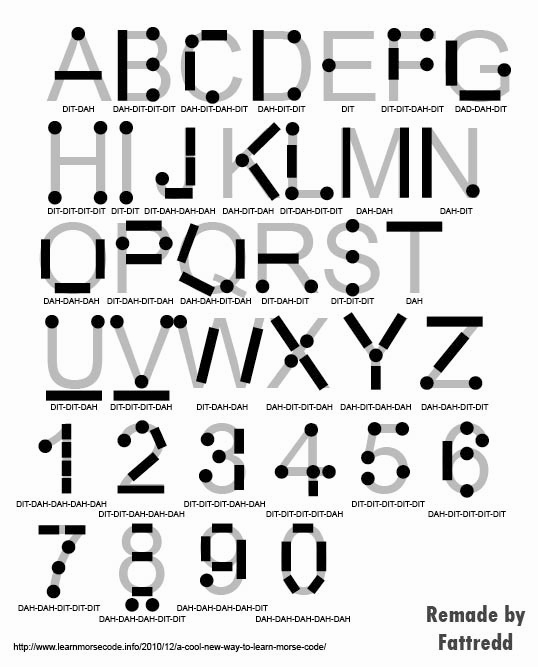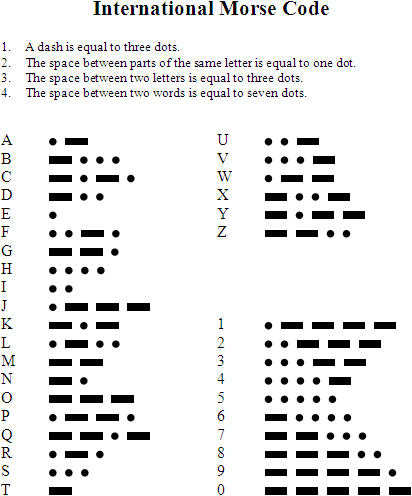Learning Morse Code is just like learning a new brand new language and as such needs a plan of attack and practice. Here are some ideas:
Morse Code Tip #1: Slow and Steady Wins the Race
Begin to learn Morse Code by starting out with the easiest and simplest letters in the alphabet.
Some of the easiest letters are:
- E (. or dit)
- T (- or dah)
- M (– 0r dah dah)
- I (.. or dit dit)
These Morse Code letters are the only letters in Morse Code that use one or two dits and dahs and do not combine the dits and dahs.
From there, the next easiest step is to move onto the simple dit and dah combinations, those using only 2 or 3 dits and dahs.
Here are the next Morse Code letters to learn:
- A (.- or dit dah)
- D (-.. or dah dit dit)
- G (–. or dah dah dit)
- (H) (…. or dit dit dit dit)
- K (-.- or dah dit dah)
- N (-. or dah dit)
- O (dah dah dah)
- R (.-. or dit dah dit)
- S (… or dit dit dit dit)
- U (..- or dit dit dah)
- W (.– or dit dah dah)
Finally, ending with the more difficult letters like “C”, “L”, “Q”, and “X”, that combine 4 dits and dahs in no particular “order”.
Here are the more difficult Morse Code letters:
- B (-… or dah dit dit dit)
- C (-.-. or dah dit dah dit)
- J (.— or dit dah dah dah)
- L (.-.. or dit dah dit dit)
- F (..-. or dit dit dah dit)
- Q (–.- or dah dah dit dah)
- P (.–. dit dah dah dit)
- V (…- or dit dit dit dah)
- X (-..- or dah dit dit dah)
- Y (-.– or dah dit dah dah)
- Z (–.. or dah dah dit dit)
Morse Code Tip #2: If at all possible, try to avoid visualization.
- Your ears hear the code
- Your mind says, “Hey, that’s Morse Code!”
- Your brain tries to bring up an IMAGE of the Morse Code letter or number you’ve heard
- Your brain tries to match the IMAGE to the SOUND
- Finally, you decide on a sound, or you miss the letter, and try to go on to the next letter
Morse Code Tip #3: Listen to Morse Code as often as you can.
Thanks to modern technology, you can find recordings of Morse Code just about anywhere – and you can find versions that are played back slower than what would be considered “normal” conversation.
Take advantage of these options to listen to More Code and use these recordings and videos as tools to test your learning progress.
This is especially important for learning the timing and spacing between letters and between words, as well as being able to instantly and effortlessly tell the difference between a dit and dah length of time.
Morse Code Tip #4: Use Your Own Voice!
Like most languages, Morse Code is both a written and auditory language. To prepare for listening to and translating dits and dahs, many people find it helpful to use their own voices to sound out letters and sentences as they practice.
Another way of incorporating the learners voice is to translate a short story, children’s book, or paragraph while recording. This is a great way of creating a simple test that can be “graded” without any outside assistance later.
Morse Code Tip #5: Have Fun!
As with learning anything, the more personal, entertaining, and a part of everyday life the new skill becomes, the quicker it is learned and the better it “sticks”. This can easily be applied to Morse Code. Emails, texting, grocery lists, notes to loved ones, and journaling are all great options for incorporating Morse Code into everyday life for a little bit of fun practicing as well as getting others around you interested in a new hobby as well!
Morse Code will be Easier with a Morse Code Project Kit!
Wow, we just got our new kit in the mail – and we love it!
Our new Morse Code kit was super easy to build and fun to use – perfect for people who want to learn how to send and receive Morse Code.
Mac Learning Morse Code
Mac is an 8 year old attending regular classes and has Cerebral Palsy. He is quite the character and has a great sense of humor, and is using Morse Code to communicate!
Mac learned Morse Code through an Excel spreadsheet his mother created. It is a very nifty tool for learning Morse Code.
Here’s a video of him using two buttons to work with Morse Code, and here’s a link to Gina’s Excel spreadsheet she creating to help him learn Morse Code!
Learn Morse Code With Gina’s Excel Spreadsheet

Morse Code Titanic: The Morse Code Messages from the Titanic
Morse Code Titanic Fact 1: The Titanic Distress Call Was “CQD” – Not “SOS”
The Titanic’s radio operators, Harold Bride and Jack Philips, were employees of a radio telegraph company named “Marconi.” Marconi’s distress call then was CQD, not SOS. CQD is still a common distress call for British ships.
Morse Code Titanic Fact 2: Morse Code Operator Jack Philips Did Not Survive.
The Titanic Morse Code operator Harold Bride did make it off the ship, however, Jack Philips died from exposure.
A Cool New Way to Learn Morse Code
Together, a friend of mine and I, Bryan Campbell, designed a new Morse Code software that allows you to learn Morse Code from your computer, iPad, iPhone, or even other Smartphones.
Here’s a screenshot:
So here’s how this Morse Code Software works to help you learn Morse Code.
First, load the Morse Code Application onto your browser. Then, you’ll want to play around a bit with the Morse Code generator. As you play with the buttons, you’ll notice that the Morse Code software allows you to press the “dit,” the “dah,” “Next,” and “Start Over.” To clear the “Recent Letters” at the top of the Morse Code application, press refresh.
When you press “Next,” you’ll hear the Morse Code generator actually “Speak” the letter that you just wrote out in Morse Code using dits and dahs. In the future, we’re going to add some very cool features like, “Share this” and “Tweet this,” etc.
Please let me know your thoughts on this new Morse Code application – it’s brand new and still in Beta testing.
Jericho Morse Code – What Does Jericho Say in Morse Code?
Morse Code is used in the TV seried, “Jericho” in a variety of ways. In a few of the episodes, there is only one way to communicate – and that’s with Morse Code.
The transmissions Jericho with Morse Code happen pretty quickly, and the Morse Code is being transmitted pretty slopily as well.
Here is what the Jericho Morse Code says:
Jericho Episode: The Pilot
Jericho Morse Code: “Jericho Pilot”
Jericho Episode: Fallout
Jericho Morse Code: “Jericho Fallout”
Jericho Episode: Four Horsemen
Jericho Morse Code: “Jericho Three”
Jericho Episode: Walls of Jericho
Jericho Morse Code: “He knows Rob”
Jericho Episode: Federal Response
Jericho Morse Code: “There is a fire”
Jericho Episode: “9.02″
Jericho Morse Code: “The EMP hits”
Jericho Morse Code: Long Live the Mayor
Jericho Morse Code: “Pray for NYC”
Jericho Episode: Rogue River
Jericho Morse Code: Rob not FBI
I hope this helps!
Morse Code Alphabet Video – Learn Morse Code
Here’s a Morse Code video I created which gives the Alphabet in Morse Code.
httpv://www.youtube.com/watch?v=kDeVR6sWFZ4
I basically give the Morse Code alphabet one letter at a time – plus, there’s a secret message in the beginning of the video which will be fun to decode! Email me if you figure out what the secret message means.
Learn Morse Code in only 6 Steps
Morse Code – From a SmartPhone App?
W0w, I just came across http://buzzbuka.dsemeas.com/Buzzbuka.html which looks like its a pretty cool SmartPhone app for iPhone, Droid, or iPads.
It looks like you can communicate in either Morse Code or with a different type of code that is not Morse. Using your volume key buttons for dashes and dots, you can pound out a message to your friend in Morse Code.
But – that doesn’t solve the problem! You need to LEARN Morse code before you start using it in conversations with your friends.
Still, this app might be a great way to hone your skills and give you motivation to learn Morse Code – because if you don’t know the Code, how will you send it to your friends?
You won’t.
So, for $0.99 cents, why not? Give it a try. You’ll be sending and receiving Morse Code before you know it, and eventually may love it so much you decide to get your Ham Radio license!



